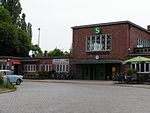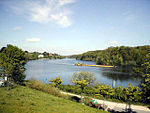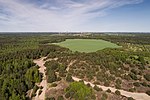Steinstücken
Berlin WallEnclaves and exclavesSteglitz-ZehlendorfZones of Berlin

Steinstücken (German: [ˈʃtaɪ̯nˌʃtʏkŋ̍] (listen), literally "Stone Pieces"), a small settlement with approximately 200 inhabitants, is the southernmost territory of the Berlin borough of Steglitz-Zehlendorf, belonging to Wannsee. From the division of Germany in 1949 until a connecting corridor was created in 1971–72, Steinstücken was the only permanently inhabited of twelve original exclaves of West Berlin in East Germany, while West Berlin itself was an enclave controlled by the Western Allies, surrounded either by East Berlin or East German (GDR) territory.
Excerpt from the Wikipedia article Steinstücken (License: CC BY-SA 3.0, Authors, Images).Steinstücken
Bernhard-Beyer-Straße, Berlin Stern
Geographical coordinates (GPS) Address Nearby Places Show on map
Geographical coordinates (GPS)
| Latitude | Longitude |
|---|---|
| N 52.39 ° | E 13.130833333333 ° |
Address
Bernhard-Beyer-Straße 3
14109 Berlin, Stern
Brandenburg, Germany
Open on Google Maps









